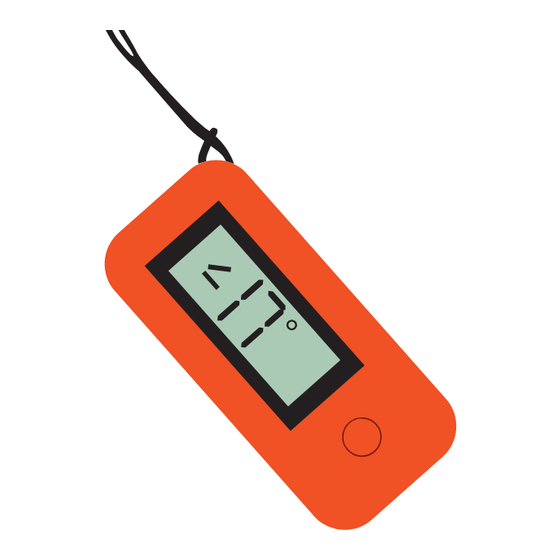
Advertisement
WHY SLOPE ANGEL:
• Slope Angel is an essential aid that enables assessment of the safety of the terrain when skiers,
mountaineers, hikers and rescue teams venture into the mountains away from marked pistes and trails.
• Two of the vital factors in identifying avalanche terrain are slope angle and air temperature.
• Slope Angel is an electronic inclinometer and thermometer, designed to accurately measure mountain
slope gradients between 0º to 90º and air temperature ºC and ºF.
OPERATING INSTRUCTIONS:
1.
Place a ski pole,
ice axe or similar on
the slope parallel to
the slope axis.
Slide out cue cards
2.
Place the Slope
Angel onto the
ski pole and press
the on button.
3.
Slope Angel will
display the angle
of the slope and air
temperature.
4.
After 16 seconds
Slope Angel will turn
off automatically.
Advertisement
Table of Contents

Summary of Contents for Slope Angel SLOPE ANGEL V1.0
- Page 1 Slide out cue cards WHY SLOPE ANGEL: • Slope Angel is an essential aid that enables assessment of the safety of the terrain when skiers, mountaineers, hikers and rescue teams venture into the mountains away from marked pistes and trails.
- Page 2 DESIGN SPECIFICATIONS: Dimensions: 50 x 20 x 8 mm Weight: 30g Casing: ABS Thermoplastic Power supply: Button cell 1225 3V replaceable battery Display: LCD Operating temperature: -30º + 60º Approvals: CE & FCC Warranty: 2 years • On button scrolls through temperature in Celsius/ Fahrenheit and slope angle •...
- Page 3 30º - 34º • Practice using your Slope Angel before departure. • Assess what type of terrain surrounds you; release areas, terrain traps, or runout areas and take advantage of safer terrain such as ridges.
- Page 4 AVALANCHE RISK CODE 5. VERY HIGH AVALANCHE RISK 1. LOW RISK 2. MODERATE 3. CONSIDERABLE 4. HIGH (EXTREME) FRENCH FLAG U.S. COLOUR CODE Low and Moderate Risk: Generally safe conditions. There are 3 main types of avalanches: Avalanches are unlikely but minor avalanches Powder: Often starts from a single point and could occur under heavy loads on a few identified accumulates snow as it moves down the slope.
- Page 5 An avalanche is a mass that can be a mix of snow ice, rocks and debris that travels down the mountain. Avalanches occur due to a number of triggers such as overloading, temperature, slope angle and snow pack conditions. Overloading occurs when the amount of falling snow or a group of skiers/mountaineers place too much weight on the slope –...
- Page 6 DISCLAIMER Whilst Slope Angel provides you with vital information, it is the responsibility of individuals to take appropriate precautions prior to departure. When planning a trip out for a day’s skiing, hiking or winter climbing etc, it is essential that you are avalanche aware. Carry out comprehensive research of the area of your activities, heeding local knowledge, weather forecasts, safety warnings and any advice available via local media regarding avalanches, piste closures, rock falls, landslides and high water levels.
Need help?
Do you have a question about the SLOPE ANGEL V1.0 and is the answer not in the manual?
Questions and answers